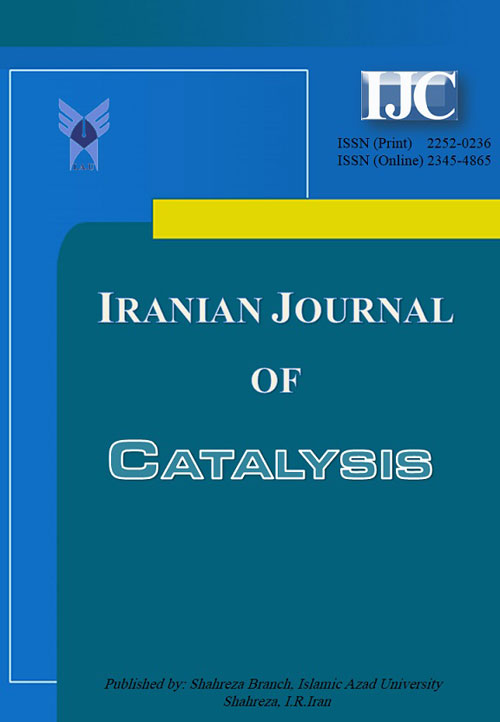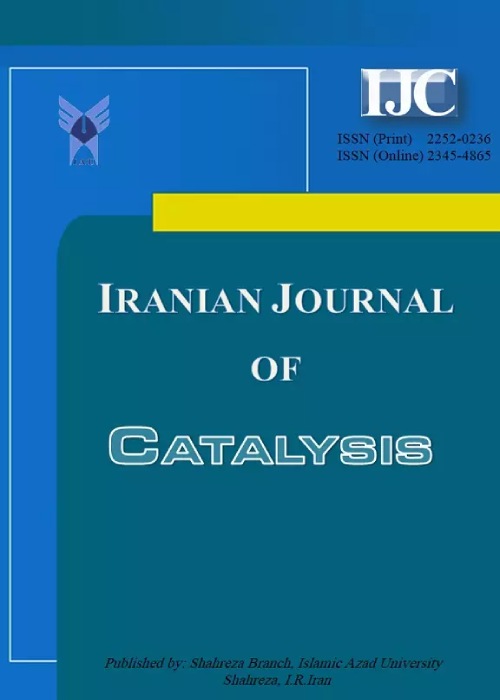فهرست مطالب

Iranian Journal of Catalysis
Volume:10 Issue: 3, Summer 2020
- تاریخ انتشار: 1399/07/02
- تعداد عناوین: 10
-
-
Pages 181-188In this study, iron nanoparticles (FeNPs) were synthesized by green route under microwave irradiation. Terminalia arjuna bark extract was used for synthesis, which acts as reducing and stabilizing agent. The synthesized FeNPs were characterised by UV-Visible spectra, X-ray diffraction (XRD), scanning electron microscopy (SEM), Fourier transform infrared spectra (FT-IR), BET surface area and UV-DRS (diffuse reflectance spectrophotometer). The absorption spectra of FeNPs showed a surface plasmon resonance (SPR) peak at 280 nm. The photocatalytic activity of rose bengal by FeNPs was studied under sunlight and UV light (250 W) of photocatalytic reactor. The percentage of photodegradation of RB was 83 % and 95 %, in about 240 min and 200 min in sunlight and UV light, respectively. The photocatalytic degradation of RB by Fe NPs follows pseudo-first order kinetics. The photodegradation of RB was confirmed by LC-MS analysis.Keywords: iron nanoparticles, Terminalia arjuna bark extract, Rose bengal, Photodegradation
-
Pages 189-194
In this article, recyclable Fe3O4@SiO2@FeCl3 was synthesized and entirely characterized by various techniques including XRD, FT-IR, SEM, EDX and VSM analysis. The catalytic ability of produced Fe3O4@SiO2@FeCl3 was studied in the aza-Michael reaction of diethyl amine and ethyl crotonate which lead to high yield of product. Also, this procedure was used to synthesize other derivatives resulted from different amines. Synthesized Fe3O4@SiO2@FeCl3 nanocatalyst has some great advantages such as easy preparation method, simple recovery and high efficiency.
Keywords: Aza-Michael reaction, Fe3O4@SiO2@FeCl3 nanocatalyst, α, β-Unsaturated carbonyl compounds -
Pages 195-201Ni0.5Cu0.5Fe2O4 magnetic nanoparticles using Arabic gel (AG) as a reducing and stabilizing agent was prepared by the sol-method. The catalyst identification was performed using Fourier transform infrared spectroscopy (FT-IR), powder X-ray diffraction (PXRD), scanning electron microscopy (SEM), and vibrating sample magnetometer (VSM). The magnetic analysis showed that the Ni0.5Cu0.5Fe2O4 had a ferromagnetic behavior with a saturation magnetization of 31.22 emu/g at room temperature. Then, Ni0.5Cu0.5Fe2O4 magnetic nanoparticles were applied as a green, convenient, effective and reusable catalyst for the one-pot three-component synthesis of tetrahydrobenzo[b]pyrans in good to excellent yields. It should be noted, the nanocatalyst is separated by a magnet was used several times and it was as efficient as ever.Keywords: ferrite, Magnetic nanoparticles, Tetrahydrobrnzo[b]pyran drivetives, Microwave irradiation, Solvent-free
-
Pages 203-208< p>In this communication, we have reported that the Pd(OAc)2–Et3SiH-DMF system promotes the microwave-assisted chemoselective reduction of aryl α,β-unsaturated esters in good yields. The protocol affords a convenient reduction of aryl-conjugated double bonds even in presence of other functional groups like esters, phenols, and ethers.Keywords: Chemoselective, Microwave, Palladium, reduction, Triethylsilane
-
Pages 209-218Activated carbon from pine cone (PCAC) was used as a precursor to prepare Fe3O4/magnetic activated carbon (MPCAC). Here, the removal of linear alkylbenzene sulfonate (LAS) was studied using catalytic ozonation process (COP) in exposure to MPCAC. Subsequently, it was compared with PCAC. Moreover, the effects of solution's initial pH, catalyst dosage, and the time of ozonation on the removal process were comparatively studied in reference to a sole ozonation process (SOP). According to the results of this study, compared with PCAC, degradability could be improved and initial concentration of LAS reduced by COP using MPCAC. Consequently, almost complete removal (>98%) of 25 mg/L of LAS was achieved under the optimum conditions (15 min ozonation time, 7 mg/min ozone flow, 0.3 g/L catalyst dosage and pH=10). Concluding, this nanocomposite is an effective active catalyst for mineralization and degradation of LAS in COP.Keywords: Magnetic activated carbon, Heterogeneous catalytic ozonation process, LAS degradation, Aqueous solution
-
Pages 219-226A bio-based magnetic nano-catalyst (Fe3O4@nano-dextrin/Ti(IV)) was synthesized via the preparation of Fe3O4@nano-dextrinas magnetic support and then its treatment with titanium tetrachloride (TiCl4). The properties of this catalyst were characterized by different kinds of techniques such as FT-IR, FESEM, TEM, ICP, XRF, VSM and TGA. As a first report, the catalytic activity of Fe3O4@nano-dextrin/Ti(IV) was investigated in the synthesisof 2,3-dihydroquinazolin-4(1H)-ones via condensation between 2-aminobenzamide and aldehyde under mild conditions. Good efficiency, a high percentage of product yields, simplicity of operation and easy recovery and reuse of catalyst are some benefits of this protocol.Keywords: Fe3O4@nano-dextrin, Ti(IV), Magnetic nano-catalyst, Lewis acid catalyst, Multi-component reactions, 3-Dihydroquinazolin-4(1H)-ones
-
Pages 227-233
The catalytic performance of Ni-Al, Mg-Al, and Co-Ni LDHs as novel nanocatalysts was evaluated in the oxidation of toluene. The samples were characterized by X-ray diffraction (XRD), scanning electron microscopy (SEM), and Fourier transform infrared spectroscopy (FTIR). The XRD and FTIR approved the structure and functional groups of the LDH, respectively. Also, the presence of cations with different oxidation state confirmed by XRD. According to this result, Mars Van Krevelen (MVK) mechanism was suggested for the combustion of toluene over the LDH nanocatalysts. The SEM results indicated that the nanostructure and layered morphology of the catalysts. All LDHs exhibited catalytic activity for toluene oxidation. T80 (temperature for 80% conversion for toluene) for Co-Ni, Ni-Al and Mg-Al LDH catalysts were 225, 277 and 350 °C, respectively. So, the Co-Ni LDH showed the highest activity. Furthermore, Ni-Al LDH exhibited the highest thermal stability. So, we concluded that Ni-Al LDH is a superior catalyst for toluene oxidation in the studied series.
Keywords: air pollution, Toluene, Nanocatalyst, Layered double hydroxides, Catalytic oxidation -
Pages 235-245Novel metal oxides have been studied worldwide due to their potential uses in ecological refinement, particularly to eliminate organic impurities present in water. In this work, we report the preparation of Ni1-xCoxAl2O4-δ (where x=0, 0.05, 0.10, 0.15 and 0.20) nanoparticles by simple chemical precipitation route. The as-synthesized spinel particles were characterized by X-ray diffraction (XRD), Fourier transform infrared spectroscopy (FT-IR), particle size analysis, scanning electron microscopy (SEM) and energy dispersive X-ray analysis (EDX), UV-Vis Spectroscopy (UV) and Photo Luminescence (PL) Spectroscopy techniques. The XRD results affirmed the development of the cubic structure in all the samples. FT-IR confirmed the presence of the M-O bond. Particle characteristics statistics showed the existence of particles in the range of 36-741 nm range. SEM analysis strengthened the presence of various sized grains (nano and micron) in the samples. EDX analysis affirmed the existence of an appropriate amount of elements (Ni, Al, Co and O) in all the samples. The band gap of Co doped NiAl2O4 was in between 2.8 – 3.0 eV, which was in line with the reported data. The PL spectra exhibited a strong peak at around 450 nm in the samples. From UV studies, the λmax was around 310 nm in all the prepared samples. The photoluminescent characteristics of the samples were confirmed by PL studies and their photoemission was found at 437 nm. Among the samples studied, the parent NiAl2O4 shows more efficiency in degrading the malachite green (MG) dye than other Co doped NiAl2O4 photocatalysts under the irradiation of visible light at the wavelength of 616nm at normal temperature.Keywords: Co doped NiAl2O4 nanoparticles, Organic pollutant, Photodegradation, Characterization, Photocatalysis
-
Pages 247-251
Mohammad Dashteh was born in 1994 in Dashteh/ Hamedan, Iran. Having graduated in the field of Pure Chemistry (2016) from Bu-Ali Sina University, Hamedan, Iran, he continued his M.Sc. in 2018 in Organic Chemistry under the supervision of Professor Mohammad Ali Zolfigol. He is currently working towards his Ph.D. under the supervision of Professor Mohammad Ali Zolfigol and Professor Ardeshir Khazaei in the department of chemistry at Bu-Ali Sina University, Hamedan, Iran. His research interest is the design, synthesis, and characterization of task-specific biological-based catalysts and their applications in organic transformations.
Keywords: Metalloporphyrins, Applications, Chemical Properties, Catalysts -
Pages 253-257
Fatemeh Karimi was born in 1984 in Shahreza/ Isfahan, Iran. She received her B.Sc. in pure Chemistry (2006) and M.Sc. in Organic Chemistry (2008) from Isfahan University of Technology, Iran, under the supervision of professor Abdol Reza Hajipour. She is currently working towards her Ph.D. under the supervision of professor Mohammad Ali Zolfigol at Bu-Ali Sina University. Her research interest is organic methodology especially the design, synthesis, characterization and applications of nanomagnetic catalysts in organic synthesis.
Keywords: Nafion-H®, Catalytic applications


